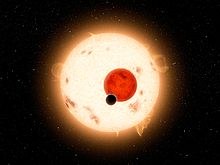Circumbinary planet
A circumbinary planet is a planet that revolves around a binary star .
Emergence
It is believed that the binary stars and the planets orbiting them originated from a common accretion disk . An indication of this is that all orbits of circumbinary planets detected by the transit method are coplanar ; H. the orbit of the binary star system and that of the planet lie in one plane. Another indication is the measurement of the Rossiter-McLaughlin effect , according to which the axis of rotation of the circumbinary planets is perpendicular to their orbital plane and the planets rotate in the direction of their orbit. However, they cannot have originated in the place where they are observed. Within ten astronomical units , the dynamic influences on the orbits of the planetesimals are so great that they revolve around the binary star system on elliptical orbits. In the event of a collision, these planetesimals destroy each other due to the high relative speeds instead of sticking to each other and forming a planet. The circumbinary planets have therefore subsequently moved to their current location, like Hot Jupiter .
Determination of the mass
The radii of the planets can be determined by the depth of the fall-off of light during transit , but not their masses. However, circumbinary planets - in contrast to planets around single stars - also influence the orbit of the central binary star system. The masses of the planets can be estimated from the shifts in the occultations caused by the planets and from the small time variations during the transitions in front of the disc of the two stars, if the masses of the double stars are known. However, since the planets revolve around the common gravitational center in wide orbits for reasons of stability, exact values are not yet available.
proof
Transit method
Evidence of circumbinary planets by the transit method is undisputed, i.e. if they cause a small darkening of the star surface when passing in front of the stars of the binary system.
Time of flight effect
Due to the time- of- flight effect in eclipsed stars , circumbinary planets can only be assumed so far. An indirect detection of circumstellar planets can be made by the changes in the points in time of minimum brightness due to a change in the covering light of the two stars in a binary star system.
These planets, presumed by the light travel time effect, have been shown at HW Vir, NY Vir, UZ For, RR Cae, HU Aqr, DP Leo, NN Ser and NSVS 14256825. None of these planetary orbits seem to be coplanar, since it was not possible to observe transits through the planets in these binary star systems. Furthermore, many of the orbits are not dynamically stable over a longer period of time, since the assumed planetary masses would have to be very high in order to have a measurable effect on the stars. Furthermore, it has not yet been possible to predict the further course of the deviations of the minimum eclipse from a linear ephemeris , since superimposed effects such as mass transfers between the stars or magnetic activity on the stars influence the times of minimum brightness. The circumbinary planets suspected via the light travel time effects still require independent confirmation.
Examples
By January 12, 2020, circumbinary planets were discovered in the following binary star systems using the transit method:
Individual evidence
- ↑ Stefano Meschiari: CIRCUMBINARY PLANET FORMATION IN THE KEPLER-16 SYSTEM. I. N-BODY . In: Astrophysics. Solar and Stellar Astrophysics . 2012, arxiv : 1204.1314 .
- ↑ Roman R. Rafikov: HOW TO BUILD TATOOINE: REDUCING SECULAR EXCITATION IN KEPLER CIRCUMBINARY PLANET FORMATION . In: Astrophysics. Solar and Stellar Astrophysics . 2012, arxiv : 1212.2217 .
- ^ William F. Welsh et al .: The Transiting Circumbinary Planets Kepler-34 and Kepler-35 . In: Astrophysics. Solar and Stellar Astrophysics . 2012, arxiv : 1204.3955 .
- ↑ Laurance R. Doyle et al .: Kepler-16: A Transiting Circumbinary Planet . In: Astrophysics. Solar and Stellar Astrophysics . 2011, arxiv : 1109.3432 .
- ^ J. Horner et al .: A Dynamical Analysis of the Proposed Circumbinary HW Virginis Planetary System . In: Astrophysics. Solar and Stellar Astrophysics . 2012, arxiv : 1209.0608 .
- ↑ S.-B. Qian, L.-Y. Zhu, Z.-B. Dai, E. Fernández Lajús, F.-Y. Xiang, J.-J. He: A Dynamical Analysis of the Proposed Circumbinary HW Virginis Planetary System . In: Astrophysics. Solar and Stellar Astrophysics . 2011, arxiv : 1112.4269 .
- ↑ Megan LA Almeida, F. Jablonski, CV Rodrigues: circumbinary planets: Two circumbinary planets in the eclipsing post-common envelope system NSVS 14256825 . 2012, arxiv : 1210.3055 .
- ↑ Megan E. Schwamb, Jerome A. Orosz, Joshua A. Carter, William F. Welsh, Debra A. Fischer, Guillermo Torres, Andrew W. Howard, Justin R. Crepp, William C. Keel, Chris J. Lintott, Nathan A. Kaib, Dirk Terrell, Robert Gagliano, Kian J. Jek, Michael Parrish, Arfon M. Smith, Stuart Lynn, Robert J. Simpson, Matthew J. Giguere, Kevin Schawinski: Planet Hunters: A Transiting Circumbinary Planet in a Quadruple Star System . 2012, doi : 10.1086 / 319061 , arxiv : 1210.3612 .
